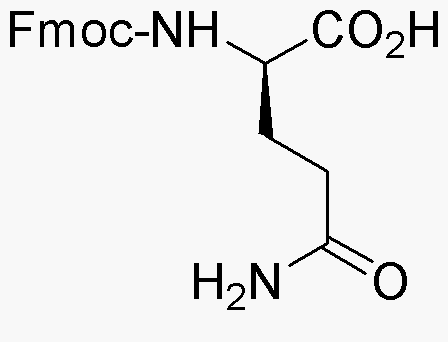Fmoc-D-glutamine is widely utilized in research focused on:
- Peptide Synthesis: This compound serves as a protective group in the synthesis of peptides, allowing for the selective modification of amino acids, which is crucial in developing new therapeutic peptides.
- Drug Development: It plays a significant role in the pharmaceutical industry for creating drug candidates, particularly in designing compounds that target specific biological pathways.
- Biotechnology: Researchers use Fmoc-D-glutamine in the production of recombinant proteins, enhancing the efficiency of expression systems in biotechnological applications.
- Diagnostics: This chemical is valuable in the development of diagnostic tools, particularly in assays that require specific peptide interactions, aiding in disease detection and monitoring.
- Material Science: It is also explored in the creation of biomaterials, where its properties can be harnessed to develop materials for tissue engineering and regenerative medicine.
General Information
Properties
Safety and Regulations
Applications
Fmoc-D-glutamine is widely utilized in research focused on:
- Peptide Synthesis: This compound serves as a protective group in the synthesis of peptides, allowing for the selective modification of amino acids, which is crucial in developing new therapeutic peptides.
- Drug Development: It plays a significant role in the pharmaceutical industry for creating drug candidates, particularly in designing compounds that target specific biological pathways.
- Biotechnology: Researchers use Fmoc-D-glutamine in the production of recombinant proteins, enhancing the efficiency of expression systems in biotechnological applications.
- Diagnostics: This chemical is valuable in the development of diagnostic tools, particularly in assays that require specific peptide interactions, aiding in disease detection and monitoring.
- Material Science: It is also explored in the creation of biomaterials, where its properties can be harnessed to develop materials for tissue engineering and regenerative medicine.
Documents
Safety Data Sheets (SDS)
The SDS provides comprehensive safety information on handling, storage, and disposal of the product.
Product Specification (PS)
The PS provides a comprehensive breakdown of the product’s properties, including chemical composition, physical state, purity, and storage requirements. It also details acceptable quality ranges and the product's intended applications.
Certificates of Analysis (COA)
Search for Certificates of Analysis (COA) by entering the products Lot Number. Lot and Batch Numbers can be found on a product’s label following the words ‘Lot’ or ‘Batch’.
*Catalog Number
*Lot Number
Certificates Of Origin (COO)
This COO confirms the country where the product was manufactured, and also details the materials and components used in it and whether it is derived from natural, synthetic, or other specific sources. This certificate may be required for customs, trade, and regulatory compliance.
*Catalog Number
*Lot Number
Safety Data Sheets (SDS)
The SDS provides comprehensive safety information on handling, storage, and disposal of the product.
DownloadProduct Specification (PS)
The PS provides a comprehensive breakdown of the product’s properties, including chemical composition, physical state, purity, and storage requirements. It also details acceptable quality ranges and the product's intended applications.
DownloadCertificates of Analysis (COA)
Search for Certificates of Analysis (COA) by entering the products Lot Number. Lot and Batch Numbers can be found on a product’s label following the words ‘Lot’ or ‘Batch’.
*Catalog Number
*Lot Number
Certificates Of Origin (COO)
This COO confirms the country where the product was manufactured, and also details the materials and components used in it and whether it is derived from natural, synthetic, or other specific sources. This certificate may be required for customs, trade, and regulatory compliance.
*Catalog Number
*Lot Number
Citations
Sign up and save
Entice customers to sign up for your mailing list with discounts or exclusive offers.


